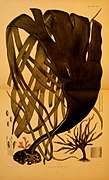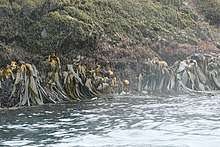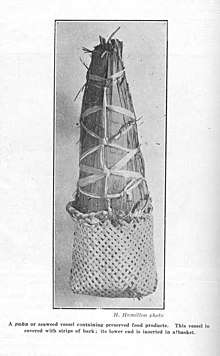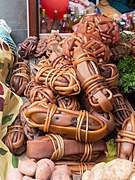Durvillaea antarctica
Durvillaea antarctica, also known as cochayuyo and rimurapa,[1] is a large, robust species of southern bull kelp found on the coasts of Chile, southern New Zealand, and Macquarie Island.[2][3][4][5] D. antarctica, an alga, does not have air bladders, but floats due to a unique honeycomb structure within the alga's blades, which also helps the kelp avoid being damaged by the strong waves.[6][7]
| Durvillaea antarctica | |
|---|---|
| Durvillea antarctica. Washed up on Sandfly Bay, Otago, New Zealand | |
| Scientific classification | |
| Kingdom: | Chromista |
| Phylum: | Ochrophyta |
| Class: | Phaeophyceae |
| Order: | Fucales |
| Family: | Durvillaeaceae |
| Genus: | Durvillaea |
| Species: | D. antarctica |
| Binomial name | |
| Durvillaea antarctica (Chamisso) Hariot | |
Taxonomy
The species was first described in 1822,[8] as Fucus antarcticus, and revised in 1892 as Durvillaea antarctica.[9] The genus name Durvillaea was given in memory of the French explorer Jules Dumont d'Urville, while the Latin derived epithet refers to antarctic.[10]
In 2012, a taxonomic revision led to the recognition of a new species, Durvillaea poha, based on genetic, morphological and ecological evidence,[3] which was previously recognised as the 'cape' lineage of Durvillaea antarctica.[3][11][12] D. poha is the only other species in the genus to share the honeycombed structure and buoyancy of D. antarctica. D. poha occurs only in southern New Zealand and on subantarctic islands (including Snares and Auckland Islands), whereas D. antarctica has a wider distribution, and is found around New Zealand, Chile and other subantarctic islands. In southern New Zealand, D. poha and D. antarctica can be found growing together, although D. poha normally grows higher up or further back on the rock platforms, or in more sheltered bays, where wave force is weaker. D. poha generally has wider fronds than D. antarctica, and can appear more 'orange' across the frond area.[3][5]
Further diversity, with additional unclassified lineages have been identified within the species.[5][12]
|
Description
The blades of Durvillaea antarctica are green to golden brown with a leathery texture. The honeycomb structure of the blade gives strength and buoyancy.[6][7] This novel structure is thought to be responsible for the wide distribution of this genus, as the kelp is able to float when its holdfast fails. It can colonise other coastlines in this manner, and has been shown to carry communities of invertebrates across vast ocean distances from one shore to another.[13] It is thought that this 'rafting' with Durvillaea antarctica and other floating seaweeds allowed a wide range of species to recolonise sub-Antarctic shores scoured clean by ice during the last Ice Age.[14]
The holdfast of D. antarctica is large and is very difficult to remove. D. antarctica has to resist forces equivalent to 1100 km/h on land.[15] The holdfast failing is usually the result of worms and molluscs which feed on the tissue because of the sheltered habitat it creates.[16] It is also common for its host rock to be broken off without the holdfast losing its grip, with this contributing significantly to erosion in some areas.[2] Recruitment rates of this species is very low, therefore the ecological impact of harvesting this species is too great.[16]
_-_cut-away_and_cross-section_2.jpg) Cross-section revealing the honeycomb structure of blades
Cross-section revealing the honeycomb structure of blades- Another cross-section
- The long, narrow and dark blades of D. antarctica
 Illustration of D. harveyi, now D. antarctica, by Walter Hood Fitch for J. D. Hooker's Flora Antarctica, 1843–1859
Illustration of D. harveyi, now D. antarctica, by Walter Hood Fitch for J. D. Hooker's Flora Antarctica, 1843–1859
Life cycle
Durvillaea antarctica reproduces sexually by producing egg and sperm that are released into the water. Eggs and sperm are produced on specific sites of the frond. A large individual can produce 100 million eggs in twelve hours.[16] The season when reproduction occurs varies with location, but is generally during winter months.
Distribution

Durvillaea antarctica has a circumpolar distribution between the latitudes of 29°S and 55°S, found in Chile, southern New Zealand, and Macquarie Island.[2][3][4][5][17] The type locality is Cape Horn, Chile.[6]
It is found on exposed shores, especially in the northern parts of its range, and attaches itself with a strong holdfast.[2][3]
Epifauna and rafting
Holdfasts of D. antarctica are often inhabited by a diverse array of epifaunal invertebrates, many of which burrow into and graze on the kelp. In New Zealand, epifaunal species include the crustaceans Parawaldeckia kidderi, P. karaka and Limnoria stephenseni, and the molluscs Cantharidus roseus, Onchidella marginata, Onithochiton neglectus, and Sypharochiton sinclairi.[18][19][20]
Plants of D. antarctica can from detach substrates, particularly during storms. The kelp floats as a raft and can travel vast distances at sea, driven by ocean currents. Kelp-associated invertebrates can be transported inside of drifting holdfasts, potentially leading to long-distance dispersal and a significant impact upon the population genetic structure of those species.[18][19][20]
Human use
Chilean culture
Use in cuisine
Stems and holdfasts of D. antarctica and D. incurvata are harvested from the coast of Chile and is used in Chilean cuisine for various recipes, including salads and stews.[5] In Quechua the species is called: cochayuyo (cocha: lake, and yuyo: weed), and hulte.[5] The Mapuche indigenous people refer to it as collofe or kollof.[5][21]
Expression
The expression remojar el cochayuyo (literally: to soak the cochayuyo) is used in Chilean Spanish to refer to sexual intercourse.[22] The expression derives from the fact that harvested D. antarctica is preserved by being sun-dried and then softened by soaking in a dish of water.
Māori culture
Along with D. poha, blades of D. antarctica are used to make traditional pōhā bags, which are used to carry and store food and fresh water, to propagate live shellfish, and to make clothing and equipment for sports.[23][24][25] Pōhā are especially associated with Ngāi Tahu and are often used to carry and store muttonbird (tītī) chicks.[23][24] The species is called rimurapa in Māori.[1][23][24]
References
- "rimurapa". māoridictionary.co.nz. Retrieved 21 November 2019.
- Smith, J.M.B. and Bayliss-Smith, T.P. (1998). Kelp-plucking: coastal erosion facilitated by bull-kelp Durvillaea antarctica at subantarctic Macquarie Island, Antarctic Science 10 (4), 431–438. doi:10.1017/S0954102098000522.
- Fraser, Ceridwen I.; Spencer, Hamish G.; Waters, Jonathan M. (2012). "Durvillaea poha sp. nov. (Fucales, Phaeophyceae): a buoyant southern bull-kelp species endemic to New Zealand". Phycologia. 51 (2): 151–156. doi:10.2216/11-47.1.
- Parvizi, Elahe; Craw, Dave; Waters, Jonathan M. (2019). "Kelp DNA records late Holocene paleoseismic uplift of coastline, southeastern New Zealand". Earth and Planetary Science Letters. 520: 18–25. Bibcode:2019E&PSL.520...18P. doi:10.1016/j.epsl.2019.05.034.
- Fraser, Ceridwen I.; Velásquez, Marcel; Nelson, Wendy A.; Macaya, Erasmo C.A.; Hay, Cameron (2019). "The biogeographic importance of buoyancy in macroalgae: a case study of the southern bull‐kelp genus Durvillaea (Phaeophyceae), including descriptions of two new species". Journal of Phycology. doi:10.1111/jpy.12939.
- W. A., Nelson (2013). New Zealand seaweeds : an illustrated guide. Wellington, New Zealand: Te Papa Press. p. 66. ISBN 9780987668813. OCLC 841897290.
- Maggy Wassilieff. Seaweed - Bull kelp’s honeycombed structure, Te Ara - the Encyclopedia of New Zealand, Ministry of Culture and Heritage. Updated 2 March 2009. Retrieved 9 March 2010.
- Choris, L. (1822). Voyage pittoresque autour du monde. Part I. pp. vi + 17, 12 plates. Paris
- Hariot, P. (1892). Complément à la flore algologique de la Terre de Feu. Notarisia 7: 1427-1435.
- Guiry, M.D.; Guiry, G.M. (2008). "'Durvillaea antarctica'". AlgaeBase. World-wide electronic publication, National University of Ireland, Galway.
- Fraser, Ceridwen I.; Hay, Cameron H.; Spencer, Hamish G.; Waters, Jonathan M. (2009). "Genetic and morphological analyses of the southern bull kelp Durvillaea antarctica (Phaeophyceae: Durvillaeales) in New Zealand reveal cryptic species". Journal of Phycology. 45 (2): 436–443. doi:10.1111/j.1529-8817.2009.00658.x.
- Fraser, C.I.; Winter, D.J.; Spencer, H.G.; Waters, J.M. (2010). "Multigene phylogeny of the southern bull-kelp genus Durvillaea (Phaeophyceae: Fucales)". Molecular Phylogenetics and Evolution. 57 (3): 1301–11. doi:10.1016/j.ympev.2010.10.011. PMID 20971197.
- Fraser CI, Nikula R & Waters JM (2011) Oceanic rafting of a coastal community. Proceedings of the Royal Society, B, 278:649-655.
- Fraser CI, Nikula R, Spencer HG & Waters JM (2009) Kelp genes reveal effects of subantarctic sea ice during the Last Glacial Maximum. Proceedings of the National Academy of Sciences, USA, 106:3249-3253.
- Hurd, C (2003). The Living Reef. Nelson, New Zealand: Craig Potton Publishing.
- Bradstock, M (1989). Between the Tides. New Zealand: David Bateman Limited.
- Parvizi, Elahe; Fraser, Ceridwen I.; Dutoit, Ludovic; Craw, Dave; Waters, Jonathan M. (2020). "The genomic footprint of coastal earthquake uplift". Proceedings of the Royal Society B. 287: 20200712. doi:10.1098/rspb.2020.0712.
- Nikula, Raisa; Fraser, Ceridwen I.; Spencer, Hamish G.; Waters, Jonathan M. (2010). "Circumpolar dispersal by rafting in two subantarctic kelp-dwelling crustaceans". Marine Ecology Progress Series. 405: 221–230. Bibcode:2010MEPS..405..221N. doi:10.3354/meps08523.
- Nikula, Raisa; Spencer, Hamish G.; Waters, Jonathan M. (2013). "Passive rafting is a powerful driver of transoceanic gene flow". Biology Letters. 9 (1): 20120821. doi:10.1098/rsbl.2012.0821. PMC 3565489. PMID 23134782.
- Waters, Jonathan M.; King, Tania M.; Fraser, Ceridwen I.; Craw, Dave (2018). "An integrated ecological, genetic and geological assessment of long-distance dispersal by invertebrates on kelp rafts". Frontiers of Biogeography. 10 (3/4): e40888. doi:10.21425/F5FBG40888.
- Stuart, Jim (15 April 2010). "Seaweed: Cochayuyo and Luche". Eating Chilean.
- La Ficha Pop Archived 2011-06-14 at the Wayback Machine, La Cuarta, 31 October 2006.
- "Page 4. Traditional use of seaweeds". Te Ara: The Encyclopedia of New Zealand. 12 Jun 2006. Retrieved 19 November 2019.
- "Traditional Māori food gathering". Museum of New Zealand Te Papa Tongarewa. 2016-05-30. Retrieved 21 November 2019.
- "Maori shellfish project wins scholarship". SunLive. 13 May 2018. Retrieved 26 November 2019.
External links
- Algaebase: 'Durvillaea antarctica (Chamisso) Hariot
- Museum of New Zealand Te Papa Tongarewa: Durvillaea antarctica (Cham.) Har. (Species)
| Wikispecies has information related to Durvillaea antarctica |
| Wikimedia Commons has media related to Durvillaea antarctica. |


.jpg)
.jpg)